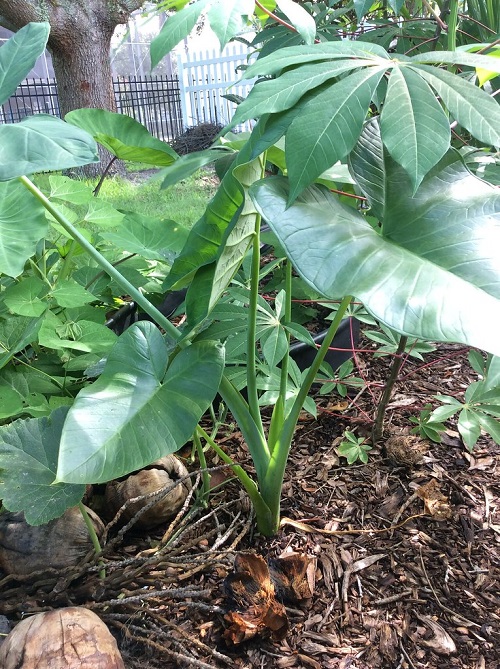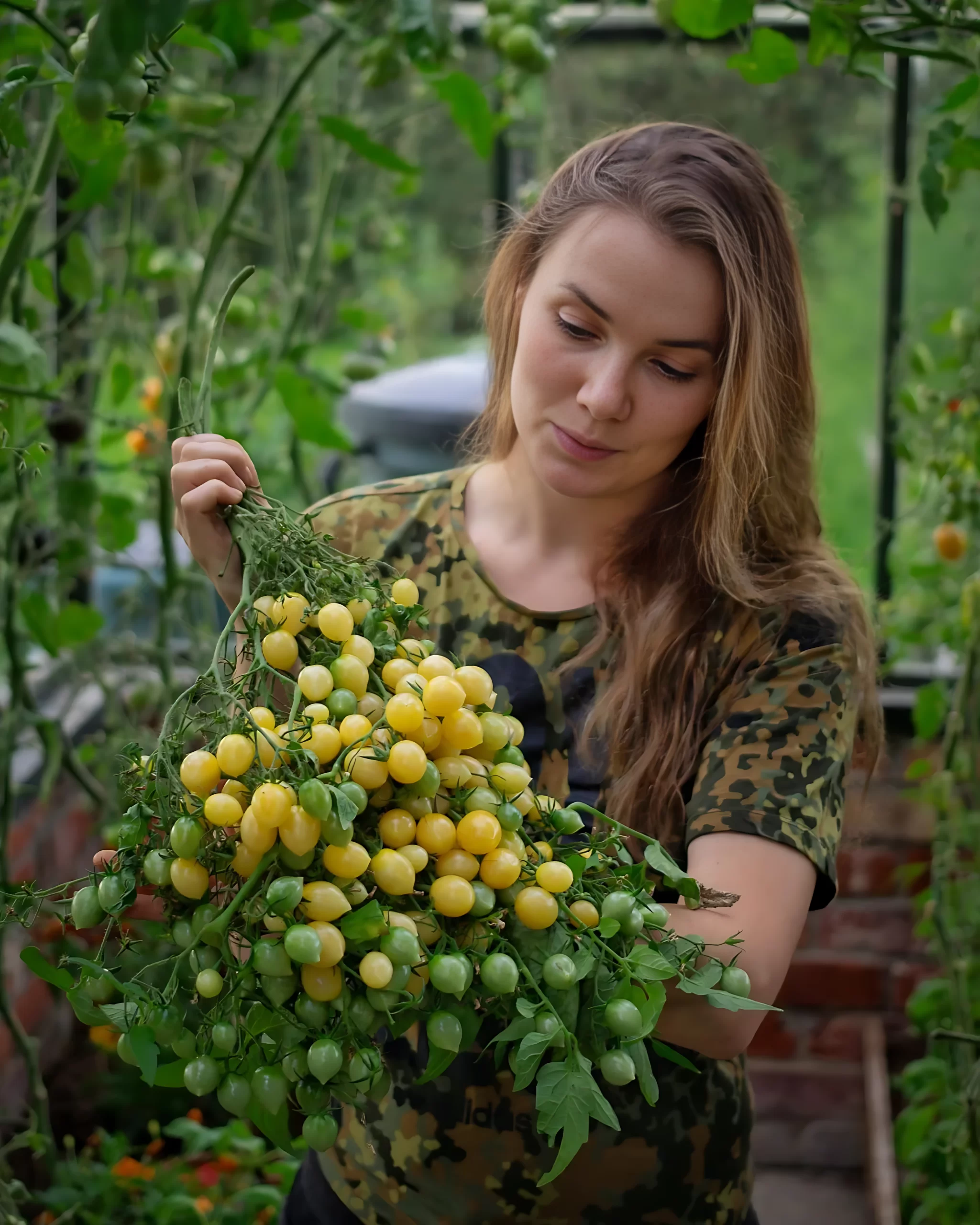From planting tips to expert care advice, unlock the joy of Growing Malanga and create a bountiful harvest for your culinary delights!
Here’s Everything About Growing Malanga, from care tips, pot size, growth needs, and much more, so you can relish the plant’s amazing tubers and foliage in your home!
Here’s How to Grow Unlimited Supply of Onions in Big Plastic Bottles at Home
Malanga Plant Information
Malanga, botanically known as Xanthosoma sagittifolium, is a fascinating plant belonging to the Araceae family. Its origins can be traced back to the tropical regions of South America, Central America, and the Caribbean.
Often mistaken for Taro and Eddo, malanga stands out with its unique features. Growing up to 5 feet tall, this plant boasts large, elephant ear-like leaves, making it an attractive addition to any garden.
The most notable aspect of Malanga lies in its tubers, which serve as a culinary delight. These tubers, also known as corms, vary in size from half a pound to two pounds and sport an earthy brown exterior, concealing their crisp and yellow to reddish flesh within. Their nutty, starchy flavor makes them a popular ingredient in various dishes across tropical regions.
Check Out The Propagation Of Philodendron Lennei Here!
Growing Malanga from Tubers
Malanga can be grown by planting the entire main tuber or secondary tubers or by using seed pieces. The best way to grow malanga is by planting the whole main tuber, as it ensures a strong start for the plant and better yields.
- Choose a sunny spot in your garden with well-draining, moist, and fertile soil.
- Prepare the soil by loosening it to a depth of 6-8 inches using a garden fork or tiller.
- Plant the malanga tubers in the soil with the pointed side facing up, about 3-5 inches deep, and space them 2 feet apart in rows that are 3 feet apart.
- Water the tubers immediately after planting and keep the soil consistently moist throughout the growing season.
- Soon, you will see the Malanga plant emerging.
You can harvest the Malanga tubers 6-7 months after planting when the leaves start to yellow and die back.
Note: Remember, Malanga is a tropical plant, so if you live in a colder climate, it’s best to grow it as an annual or in a greenhouse. With proper care, you’ll enjoy a bountiful harvest of delicious Malanga tubers to savor and share with others.
Best Pot Size for Growing Malanga
For growing Malanga in containers, it’s essential to choose the right pot size to ensure healthy growth and ample tuber production. Opt for a large container, preferably at least 18 inches in diameter and 18 inches deep.
Malanga plants have an extensive root system, and providing enough space for their roots to spread will promote better nutrient uptake and overall plant health. A larger pot also helps to retain moisture and prevents the plant from drying out quickly in hot weather.
When to Plant Malanga
The best time to plant Malanga is in the spring after the last frost has passed and the soil has warmed up. Malanga thrives in warm temperatures and requires at least 20°C (68°F) to grow well.
By planting in the spring, the plant has enough time to establish its roots and grow vigorously during the warm growing season. This allows it to produce healthy and abundant tubers by the time of harvest, which typically occurs around 6-7 months after planting.
If you live in a region with colder winters, consider growing malanga indoors or in a greenhouse before transplanting it outside in the spring to ensure a successful growing season.
Malanga Fact: Did you know? Malanga tubers have a nutty, starchy flavor, similar to chestnuts or taro. This unique taste makes them a popular ingredient in a variety of dishes, especially in Latin American and Caribbean cuisines.
Here are the Best Bulbs to Grow in Water + Growing Bulbs in Water
Requirements for Growing Malanga
Sunlight
Malanga thrives in a sunny location with full to partial sun. It requires at least 6-8 hours of sunlight per day to grow well.
If you’re growing malanga indoors, place it near a sunny window where it can receive adequate sunlight.
Soil
Malanga prefers well-draining, moist, and fertile soil. A loamy soil type with good drainage is ideal for the plant’s growth.
When growing Malanga, ensure that the soil is rich in organic matter to provide essential nutrients for healthy development.
Water
Keeping the soil consistently moist is crucial for Malanga’s growth. Regular watering is necessary, especially during dry spells or in hot weather. However, avoid waterlogging the soil, as Malanga doesn’t tolerate waterlogged conditions well.
Temperature and Humidity
Malanga thrives in warm and humid conditions (≥ 20°C / 68°F). The plant requires temperatures above 20°C (68°F) to grow properly. It is best suited for tropical and subtropical climates with high humidity levels.
If you live in a cooler region, consider growing Malanga in a greenhouse or as an annual during the warmer months.
Malanga Plant Care

Fertilizer
To promote healthy growth and tuber production, feed the plant with a balanced fertilizer. A fertilizer with an N-P-K ratio of 10-20-20 is suitable for growing malanga.
Apply the fertilizer three times during the growing season: first at two months, then at five and seven months after planting. Avoid over-fertilization, as it may lead to excessive foliage growth at the expense of tuber development.
Pruning
While Malanga doesn’t require extensive pruning, you can remove any damaged or yellowing leaves to improve airflow and prevent the spread of diseases.
Additionally, you can trim off any flower stalks that appear, as Malanga rarely flowers and focuses its energy on tuber growth. Regularly removing dead or diseased foliage will help keep the plant healthy and visually appealing.
Pests and Diseases
Malanga is generally a hardy plant, but it may encounter some pests and diseases. Common pests that may affect Malanga include aphids, mites, and snails.
Inspect the plant regularly and take appropriate measures, such as using insecticidal soap or introducing natural predators, to control pest populations.
Malanga may be susceptible to fungal infections like root rot and leaf blight. Ensure proper soil drainage and avoid overwatering to prevent fungal issues. Applying fungicides when necessary can help protect the plant from fungal diseases.
Harvesting Malanga Plant
Harvesting Malanga is a rewarding culmination of your efforts in cultivating this versatile plant. The tubers are ready for harvesting approximately 6-7 months after planting. As the leaves start to yellow and die back, it’s a clear indication that the tubers are mature and ready for harvest.
Carefully dig up the tubers from the soil, using a garden fork or shovel to avoid damaging them. Wash the harvested tubers and peel off the brown, hairy skin before using them in your favorite recipes. Enjoy the bountiful harvest of Malanga, and relish its delicious, nutty flavor in a variety of culinary delights.
Remember to leave a few tubers in the ground if you want to save them for growing Malanga in the next growing season.
Growing Malanga – FAQs
1. Can Malanga Be Grown Indoors or in Colder Climates?
Malanga is a tropical plant and thrives in warm temperatures and high humidity. If you live in a colder region, consider growing Malanga in a greenhouse or as an annual during the warmer months. Indoor cultivation is possible if you provide enough sunlight and maintain the necessary temperature and humidity levels.
2. How to Propagate Malanga for the Next Growing Season?
Malanga can be propagated using the entire main tuber or secondary tubers. The best method is to plant the whole main tuber, as it ensures a strong start for the plant and better yields.
Check out these Natural Ways to Make Plants Grow Faster & Bigger
Simply choose a sunny spot in your garden with well-draining, moist, and fertile soil. Plant the tubers about 3-5 inches deep with the pointed side facing up and space them 2 feet apart in rows that are 3 feet apart. Water the tubers immediately after planting and keep the soil consistently moist throughout the growing season.
3. Can I Store Malanga Tubers?
Yes, you can store Malanga tubers for future use. After harvesting, wash the tubers and let them air dry. Store them in a cool, dry place with good ventilation. You can keep them at room temperature for a few weeks or in the refrigerator for an extended period.
If you plan to replant them in the next growing season, make sure to save a few healthy tubers for propagation.






